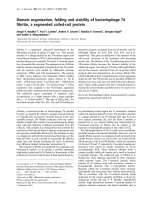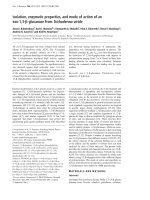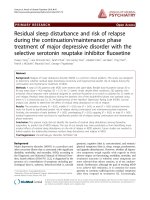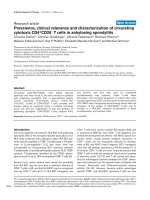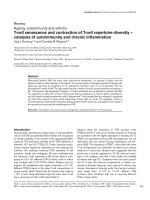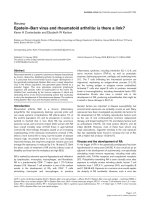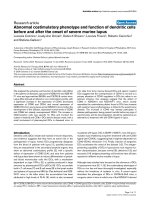Báo cáo y học: "Bench-to-bedside review: Mechanisms and management of hyperthermia due to toxicity" doc
Bạn đang xem bản rút gọn của tài liệu. Xem và tải ngay bản đầy đủ của tài liệu tại đây (72.49 KB, 8 trang )
Page 1 of 8
(page number not for citation purposes)
Available online />Abstract
Body temperature can be severely disturbed by drugs capable of
altering the balance between heat production and dissipation. If
not treated aggressively, these events may become rapidly fatal.
Several toxins can induce such non-infection-based temperature
disturbances through different underlying mechanisms. The drugs
involved in the eruption of these syndromes include sympatho-
mimetics and monoamine oxidase inhibitors, antidopaminergic
agents, anticholinergic compounds, serotonergic agents, medica-
ments with the capability of uncoupling oxidative phosphorylation,
inhalation anesthetics, and unspecific agents causing drug fever.
Besides centrally disturbed regulation disorders, hyperthermia
often results as a consequence of intense skeletal muscle
hypermetabolic reaction. This leads mostly to rapidly evolving
muscle rigidity, extensive rhabdomyolysis, electrolyte disorders,
and renal failure and may be fatal. The goal of treatment is to
reduce body core temperature with both symptomatic supportive
care, including active cooling, and specific treatment options.
Introduction
Body temperature regulation is complex and requires a
balance between heat production and dissipation. Hyper-
thermia occurs when metabolic heat production exceeds heat
dissipation. Many exogenously administered drugs are
capable of altering the body’s ability to maintain a constant
temperature.
Normal body temperature is approximately 37.0°C, although
this varies with the time of day. The Society of Critical Care
Medicine has defined fever as a body temperature of
≥38.3°C, which has gained wide acceptance [1]. Adaptive
thermogenesis by heat production is controlled through
hypothalamic regulation of the sympathetic nervous system
[2]. The preoptic nucleus of the anterior hypothalamus
responds to core temperature changes and regulates the
autonomic nervous system, inducing either cutaneous
vasodilatation, which dissipates heat, or vasoconstriction,
which conserves heat [3]. Norepinephrine, dopamine and
serotonin have all been suggested to play major roles in
regulating hypothalamic control of body temperature [4].
Sympathetic nervous system activation contributes to effects
on thermogenesis through cutaneous vasoconstriction and
nonshivering thermogenesis [5]. Thus, drugs altering the
hypothalamic levels of these neurotransmitters are capable of
altering body temperature regulation [6]. Activation of the
hypothalamic-pituitary-thyroid and the hypothalamic-pituitary-
adrenal axes are adjacent mechanisms in regulating body
core temperature that can be influenced by drugs that affect
them. Nonshivering thermogenesis occurs primarily by uncoup-
ling of oxidative phosphorylation through the activity of a group
of mitochondrial proteins known as uncoupling proteins.
Uncontrolled hyperthermia is independently associated with
increased morbidity and mortality [7]. Hyperthermia may
cause rhabdomyolysis, liver failure, disseminated intravasal
coagulation and multi-organ failure [8]. It accentuates
excitotoxic neurotransmitter release, increases production of
oxygen free radical species, accelerates cytoskeletal protein
degradation, and increases the risk of seizures [9]. A recent
publication demonstrates a nearly 30% mortality rate from all
heat-related illness presenting to the emergency department;
thus, early recognition and management of hyperthermic
reactions is essential [10]. Besides the hazards that are
inherent to hyperthermia, treatment of toxin-induced hyper-
thermia also has to account for toxin-specific complications (for
example, malignant dysrhythmia after neuroleptic overdose)
and may, therefore, become a challenge for the intensivist.
In this bench-to-bedside review we present seven conditions
in which toxin-induced hyperthermia plays an essential role,
discuss the underlying pathophysiology and suggest a
clinical approach. These conditions are summarized in
Table 1 and include: adrenergic fever caused, for example, by
cocaine, amphetamines, designer drugs or monoamine
Review
Bench-to-bedside review: Mechanisms and management of
hyperthermia due to toxicity
Florian Eyer and Thomas Zilker
Department of Clinical Toxicology, II Medizinische Klinik, Klinikum rechts der Isar, Technical University, D-81675 Munich, Germany
Corresponding author: Florian Eyer,
Published: 6 December 2007 Critical Care 2007, 11:236 (doi:10.1186/cc6177)
This article is online at />© 2007 BioMed Central Ltd
CNS = central nervous system; IPS = Infection Probability Score; MAO = monoamine oxidase; MDMA = 3,4-methylendioxymeth-amphetamine;
MH = malignant hyperthermia; NMS = neuroleptic malignant syndrome; PCP = pentachlorphenol.
Page 2 of 8
(page number not for citation purposes)
Critical Care Vol 11 No 6 Eyer and Zilker
oxidase (MAO) inhibitors; antidopaminergic fever with the
classical presentation of the neuroleptic malignant syndrome
(NMS); anticholinergic fever caused by anticholinergic
properties of drugs; serotonergic fever that is, in the majority
of cases, caused by a combination of drugs, but seldom
occurs with single agent therapy and is typically classified as
serotonin syndrome; uncoupling of oxidative phosphorylation,
most frequently caused by pentachlorphenol and salicylates;
inherited malignant hyperthermia (MH); and drug induced
fever that is not well defined resulting from inhomogeneous
classes of drugs and underlying mechanisms and probably
the most difficult to distinguish from infectious causes of
fever during a multifaceted therapy in the intensive care unit
(Table 2).
Since both recognition and treatment vary with the cause of
hyperthermia, it is important for clinicians to understand the
various presentations of, and treatments for, toxin-induced
hyperthermic syndromes. The aim of this article is to provide
intensivists with an overview of toxin-induced hyperthermic
reactions, focusing on new concepts regarding its patho-
genesis and treatment innovations.
Pathology of toxin induced temperature
disturbances and their treatment
Adrenergic fever
Intoxication with agents of the phenethylamine class (for
example, amphetamine, methamphetamine, and currently the
most popular sympathomimetic compound, 3,4-methylendi-
oxymeth-amphetamine (MDMA)) as well as cocaine and MAO
inhibitors may cause adrenergic fever [11]. MDMA and similar
serotonergic agents may cause a central deregulation of
thermogenesis through excessive serotonin and dopamine
release [12,13]. A genetic vulnerability in which the enzyme
CYP2D6 is not functional results in slower clearance and
prolonged serum levels of MDMA. Along with elevated
ambient temperature and poor hydration, motor activity
increases the toxicity of stimulants such as amphetamine and
MDMA. Besides catecholamine-mediated vasoconstriction
with the inability to dissipate heat, psychomotor agitation
leads to an increase in muscle activity with muscular heat
production. Furthermore, thermoregulation within the
hypothalamus has been suggested to be controlled by
serotonin, dopamine and norepinephrine [4]. Direct and
indirect stimulation of the hypothalamus by agents such as
MDMA, methamphetamine, cocaine and MAO inhibitors
activates the hypothalamic-pituitary-thyroid-adrenal axis, with
subsequent thermogenesis and toxicity dependent on the
level of circulating thyroid and adrenal hormones [14].
Significant elevation of norepinephrine has been
demonstrated after MDMA as well as cocaine consumption.
Acting through vascular α
1
-adrenoreceptors, norepinephrine
induces vasoconstriction and impaired heat dissipation. In
concert with elevated thyroid hormones, it also binds to and
activates α
1
- and β
3
-adrenoreceptors regulating the activity of
thermogenic tissues, such as brown fat, through uncoupling
phosphorylation [15]. In summary, hypothalamic activation
causes both impaired heat dissipation through
vasoconstriction and excess heat generation through motor
work and uncoupling. Hyperthermia (in addition to other
sometimes life threatening symptoms) in this sort of
intoxication is a sign of severe poisoning and heralds a poor
outcome. Rigorous treatment of hyperthermia is therefore
crucial.
The mainstay of therapy includes rapid and aggressive
cooling. This should be conducted by various means of
external cooling, including cool water submersion and
evaporative cooling with misting and fans [16]. The ideal way
of cooling a severely hyperthermic patient avoids intense
Table 1
Major syndromes and causes of hyperthermia due to toxicity
Major syndromes Implicated drugs
Adrenergic fever Phenethylamines such as amphetamine, methamphetamine, MDMA; cocaine and MAO inhibitors
Antidopaminergic fever (NMS) Phenothiazines, butyrophenones; atypical neuroleptics such as olanzapine and clozapine;
metoclopramide and promethazine; acute withdrawal of anti-Parkinsonian agents
Anticholinergic fever Antispasmodics, antihistamines, anti-ulcer and anti-Parkinsonian drugs, neuroleptics or ingredients of
plants (for example, belladonna alkaloids) and mushrooms
Serotonin syndrome Drugs increasing serotonin-concentration in the CNS; combination of drugs (for example, MAO inhibitors
and tricyclic antidepressants); other drugs, including dextrometorphan, meperidine, L-dopa,
bromocriptine, tramadol, lithium and the MAO inhibitor linezolid
Uncoupling of oxidative phosphorylation PCP and salicylates
Malignant hyperthermia Volatile anesthetics and depolarizing muscle relaxants
Drug induced fever Anticonvulsants, minocycline, antimicrobial agents, allopurinol, and heparin; virtually any drug capable of
causing fever via hypersensitivity mechanism
CNS, central nervous system; MAO, monoamine oxidase; MDMA, 3,4-methylendioxymeth-amphetamine; NMS, neuroleptic malignant syndrome;
PCP, pentachlorphenol.
Page 3 of 8
(page number not for citation purposes)
cooling of the skin, which stimulates shivering and vaso-
constriction. Active cooling systems via a femoral artery
catheter may be beneficial but in most cases are not needed.
Benzodiazepine or barbiturate administration and, in severe
cases, muscle relaxation should be used to stop myotonic or
hyperkinetic thermogenesis [17]. Carvedilol reduces MDMA
hyperthermia and rhabdomyolysis as an antagonist of β
1,2,3
-
adrenoceptor as well as α
1
-adrenoceptor. Thus, it is a more
attractive treatment choice for sympathomimetic syndromes
than other nonselective β-blockers, such as propranolol and
nadolol. However, the only two animal studies supporting the
usefulness of this therapy used much higher doses than are
commonly used in humans [18]. Antipyretics have no role in
therapy as they work by lowering the hypothalamic set point
in febrile patients, a mechanism that has no relevance to the
patient with hyperthermia [19]. Additional organ-orientated
supportive therapy is, therefore, essential to all these patients
(Table 3).
Antidopaminergic fever: neuroleptic malignant
syndrome
The typical temperature disturbance disorder following the
mechanism of antidopaminergic fever is NMS. It is a rare
idiosyncratic reaction typically occurring in people taking
neuroleptics or after the sudden withdrawal of dopamine
agonists, with a reported prevalence between 0.02% and
0.4% [20]. Men are affected twice as often as women [21].
Typical clinical presentation of NMS is a syndrome of
hyperthermia with temperatures >38°C as a key finding,
altered mental status, such as delirium, somnolence, coma
and mutism, ‘lead pipe’ skeletal muscle rigidity, and
autonomic dysfunction [21]. Autonomic dysfunction is mostly
seen with tachycardia, hyper- or hypotension, and
diaphoresis. Laboratory abnormalities include leukocytosis,
elevated creatine kinase and liver transaminases, and low
serum iron [22]. However, NMS can also occur in the
absence of some or all of the classic clinical features and
perhaps, therefore, presents a diagnostic challenge [23].
Differentiation between NMS and serotonin syndrome may be
difficult. Speed of onset of symptoms as well as hyperreflexia
and clonus are reported as the most distinguishing features
between these two syndromes [6]. Serotonin syndrome
typically presents acutely within 24 hours after starting
medication with clonus, hyperreflexia and myoclonus,
whereas NMS may be present at any time during drug course
of neuroleptics, with peak symptoms not occurring for days
[24].
The most common reported causatives of NMS are high-
potency neuroleptics, such as haloperidol, but also atypical
neuroleptics, such as olanzapine and clozapine [25], as well
as non-neuroleptic drugs such as metoclopramide and
promethazine [26]. Acute withdrawal of anti-Parkinsonian
agents may be a further cause [27].
The pathophysiological mechanisms underlying NMS are only
partly understood. Dopamine antagonists like phenothiazines
or butyrophenones may cause hyperthermia by altering the
thermoregulatory pathways in the anterior hypothalamus and
increasing skeletal muscle rigidity through secondary extra-
Available online />Table 2
Differential diagnosis and specific treatment in syndromes associated with hyperthermia
Syndrome Associated features Treatment
Adrenergic fever Hyperpyrexia, autonomic storm, convulsions, liver failure, Sympatholytics (for example, carvedilol),
myocardial infarction, subarachnoid hemorrhage benzodiazepines
Neuroleptic malignant Slowly progressive generalized muscular rigidity (usually Bromocriptine, dantrolene, L-dopa, amantadine, muscle
syndrome over one to three days), mental status change, autonomic relaxants
instability, hyperthermia
Anticholinergic fever Anticholinergic toxidrome: peripheral (dry red skin, Sedatives, physostigmin (controversial)
tachycardia) and central signs (mydriasis, tremor,
disorientation, coma)
Serotonin syndrome Onset within 12 hours, self-limited hyperreflexia, Serotonin antagonists as cyproheptadine and
akathisia, tremor, sustained clonus, confusion, coma, chlorpromazine, benzodiazepines, esmolol
cognitive changes, autonomic instability (often hypertensive)
Uncoupling of oxidative Tachypnea, tachycardia, and marked diaphoresis (PCP) PCP: supportive treatment, exchange transfusion
phosphorylation Intractable acidosis, renal failure, pulmonary edema and (controversial)
CNS disturbances (salicylates) Salicylates: hemodialysis
Malignant hyperthermia Fulminant muscle rigidity, hypermetabolic state, Discontinuation of anesthetics, dantrolene
hypercarbia
Drug induced fever Mainly unspecific; broad clinical spectrum from looking Discontinuation of any drugs not essentially needed;
and feeling surprisingly well to looking severely ill and distinguish from infectious causes, for example, using
profoundly septic; fever pattern varies broadly the infection probability score
PCP, pentachlorphenol.
pyramidal hyperactivity [28]. Neuroleptic-induced myotoxicity
with increased muscle metabolism resulting in hyperthermia
and rigidity is a further, but not fully convincing, theory [29]. A
recent theory favors sympathetic nervous system induced
hyperactivity of the skeletal muscle. Predisposition to
exaggerated sympathetic nervous system activity in response
to emotional or psychological stress, along with variables
such as psychotic distress or excessive dopamine antago-
nism, could pave the way to the induction of NMS [28]. This
is supported by markedly elevated catecholamines in cerebral
spinal fluid in patients with NMS; norepinephrine concen-
tration was two times greater during acute illness in these
patients than in matched controls during convalescence [30].
Similar findings have been reported for serotonin [31].
The first step in managing patients with NMS is recognition of
the syndrome and removal of the offending drug. Physical
cooling and supportive care is essential. The most commonly
recommended drugs for treatment are bromocriptine and
dantrolene. However, this is solely based on single case
reports and retrospective reviews. Bromocriptine, a centrally
acting dopamine analogue, is recommended at a dosage of
2.5 mg every 8 hours given orally [32]. Sodium dantrolene (a
non-specific muscle relaxant known for its ability to terminate
episodes of malignant hyperthermia) is recommended
through inhibition of calcium release from the sarcoplasmatic
reticulum, thus decreasing muscle contraction [22]. Adminis-
tration of sodium dantrolene may be considered in patients
who develop temperatures above 40°C, extensive rhabdo-
myolysis, coma and cardiorespiratory or renal failure [33,34].
It has been suggested that the initial dosage should be
2 mg/kg given intravenously. This dose may be repeated
every 10 minutes, up to a total dose of 10 mg/kg per day. The
oral dosage has ranged from 50 to 200 mg/day. Hepatic
toxicity may occur with doses >10 mg/kg/day [34].
Other dopaminergic drugs, such as L-dopa or amantadine,
have been reported to have a beneficial role [35]. As a
supposed mechanism of heat production in NMS points to
presynaptic involvement, a further therapeutic option includes
mechanical ventilation and muscle relaxation in severe cases,
which may result in rapid lowering of increased muscle
activity and heat production [33].
Anticholinergic fever
Hyperthermia in anticholinergic fever is caused by both
central and peripheral muscarinic receptor blockade whereas
central effects depend on the drug’s blood-brain permeability.
There is a long list of anticholinergic agents, such as
antispasmodics, antihistamines, anti-ulcer and anti-Parkin-
sonian drugs, neuroleptics and ingredients of plants (for
example, belladonna alkaloids) and mushrooms. Central
blockade may produce altered mental status, confusion,
agitation, restlessness, seizures, and coma. Peripherally,
anticholinergic blockade interferes with cutaneous loss of
heat by impairing sweat gland function. Other symptoms
comprise the anticholinergic toxidrome, including dry mouth
and axillae, mydriasis, tachycardia, flushing, urinary retention
and decreased bowel sounds [17]. Inability to lose heat and
increased muscle activity both result in hyperthermia.
Children are more likely to develop temperature disturbances
than adults due to their immature thermoregulation
mechanism.
Treatment of hyperthermia from anticholinergic poisoning is
primarily supportive. Physostigmine, up to 1 to 2 mg/h intra-
venously, is an anticholinesterase agent that acts centrally
and peripherally on both muscarinic and nicotinic receptors.
However, due to its side effect profile (mainly induction of
seizures and bradycardia), its use is rarely indicated [36].
External cooling and sedation or paralysis may be required for
uncontrolled hyperthermia [17].
Serotonergic fever: serotonin syndrome
The serotonin syndrome is a potentially life-threatening
adverse drug reaction that results from therapeutic drug use,
intentional self-poisoning, or inadvertent interactions between
drugs. It is not an idiopathic drug reaction but a predictable
consequence of excess serotonergic agonsim of central and
peripheral serotonergic receptors [37]. In the central nervous
system (CNS), serotonin modulates attention, behavior, and
thermoregulation. Serotonergic neurons are found primarily in
the midline raphe nuclei, located in the brain stem from the
midline to the medulla [38]. The neurons of the raphe in the
Critical Care Vol 11 No 6 Eyer and Zilker
Page 4 of 8
(page number not for citation purposes)
Table 3
Generally accepted unspecific treatment options for
hyperthermia
Supportive treatment of hyperthermia
Discontinue any neuroleptic agent or precipitating drug
Maintain cardiorespiratory stability
Control airway as needed
Cool with ice, ice-water immersion, misting or fans or use intravenous
cooling techniques in severe cases
Control rigidity, agitation or seizures with diazepam or lorazepam,
titrated to effect
Stop cooling at 38°C (usually after 30 minutes)
Use rectal or urinary bladder thermocouple for monitoring temperature
Maintain euvolemic state using normal saline and maintain urinary
output at 1 to 2 ml/kg/hour
Anticipate disseminated intravasal coagulation, rhabdomyolysis, renal
and hepatic failure, and hyperkalemia
Diagnose and treat infections as encephalitis and meningitis when
clinically suspected
Avoid antipyretics, phenothiazines, and butyrophenones
Consider dantrolene or muscle relaxants in refractory cases; intubation
and ventilation are likely to be required
lower pons and medulla participate in the regulation of
nociception and motor tone. In the peripheral nervous system,
serotonin is produced primarily by intestinal enterochromaffin
cells and is involved in regulating gastrointestinal motility,
vasoconstriction, uterine contraction, and bronchus-constriction
[39]. The mechanism of serotonin syndrome is complex and
involves interaction between the environment, central
catecholamine release, the hypothalamic-pituitary-thyroid-
adrenal axis, the sympathetic nervous system, and skeletal
muscle. Excellent reviews about the pathophysiology and
clinical presentation of serotonin syndrome have been
published recently [6,40]. Stimulation of the postsynaptic
5HT1A and 5HT2A receptors contributes to serotonin
syndrome [41], but no single receptor is solely responsible.
More recently, studies have placed emphasis on 5HT2A and
D1-receptors in mediating hyperthermia [42].
Numerous compounds have been associated with serotonin
syndrome, which is reviewed in several articles [39,41].
Essentially, any drug capable of increasing the concentration
of serotonin in the CNS has the potential to cause this
syndrome, although it is most common with a combination of
drugs (for example, MAO inhibitors and tricyclic anti-
depressants). However, several drugs able to produce this
syndrome are not immediately obvious: dextrometorphan,
meperidine, L-dopa, bromocriptine, tramadol, lithium and,
most recently, the MAO inhibitor linezolid [43]. The
mechanisms by which various agents affect serotonin levels
in the intersynaptic space include: first, blockade of reuptake
(TCA, SSRIs, synthetic opioids); second, increased release
of presynaptic serotonin (amphetamines, cocaine); third,
increased synthesis (tryptophan); fourth, decreased cata-
bolism (MAO inhibitors); fifth, binding of receptor by agonists
(buspirone); and sixth, increased postsynaptic serotonin
receptor sensitivity (lithium) [41]. The excess of serotonin
produces a broad spectrum of clinical findings that may
range from barely perceptible to lethal [40].
Although serotonin syndrome is often described as a clinical
triad of mental status changes, autonomic hyperactivity and
neuromuscular abnormalities, not all of these findings are
consistently present in all patients [44]. No laboratory tests
confirm the diagnosis of serotonin syndrome. Instead, the
presence of tremor, clonus, rigor, or akathisia without
additional extrapyramidal signs should lead clinicians to
consider the diagnosis. The evolution of symptoms and their
rate of change should also be reviewed to distinguish it from
NMS. Some practicable decision-making rules to confirm the
diagnosis have been published recently [40]. It has been
further suggested that a rapid and complete response to
antiserotoninergic agents (for example, cyproheptadine) is
less likely among other hyperthermic disorders and strongly
favors the diagnosis of the serotonin syndrome [45,46].
Management of the serotonin syndrome involves the removal
of the precipitating drugs, the application of supportive care
comprising the administration of intravenous fluids and
stabilization of vital signs, control of agitation with benzo-
diazepines, control of autonomic instability (with short acting
agents such as nitroprusside and esmolol) and hyperthermia
through active cooling systems [47]. Hyperthermic patients
whose temperature is more than 41.1°C are severely ill and
should receive the above-mentioned treatment as well as
immediate sedation, neuromuscular paralysis (for example,
vecuronium) and endotracheal intubation. The two most
commonly reported beneficial drugs for treatment of
serotonin syndrome acting as 5HT2A antagonists are cypro-
heptadine and chlorpromazine [47]. However, their utility is
purely derived from case reports and has not been well-
established. The recommended starting dose is 50 to
100 mg intramuscularly for chlorpromazine and 12 to 32 mg
orally for cyproheptadine during a 24 hour period, a dose that
binds 85% to 95% of serotonin receptors [6,48]. An initial
dose of 12 mg cyproheptadine followed by 2 mg every two
hours if symptoms continue is generally recommended. Many
cases of serotonin syndrome typically resolve within 24 hours
after initiation of therapy and the discontinuation of
serotonergic agents. However, symptoms may persist in
patients taking drugs with long elimination half-lives.
Uncoupling oxidative phosphorylation
Oxidative phosphorylation requires proteins in the mito-
chondrial inner membrane transport chain to shuttle electrons
through a series of oxidation/reduction reactions that
ultimately result in oxygen being converted to CO
2
, H
2
O and
H
+
, the last of which is pumped from the cytosolic side of the
inner membrane into the inner membrane space. The
potential energy of this gradient is then converted to ATP.
When any toxin or protein short-circuits this system, this
process results in the loss of potential energy being released
as heat, a phenomenon known as uncoupling [49]. The most
common toxins capable of uncoupling are pentachlorphenol
(PCP) and salicylates [50,51].
PCP is widely used as a fungicide and wood preserver. As a
lipophilic weak acid, PCP can migrate across the inner
mitochondrial membrane, resulting in uncoupling leading to
the production of energy in the form of heat. Thus, clinical
presentation as fever, tachypnea, tachycardia, and marked
diaphoresis and hyperthermia as signs of a hypermetabolic
state are the most consistent findings [52]. Successful
management of PCP toxicity relies on the early recognition
and aggressive management of hyperthermia with passive
and active cooling techniques. Given the pathophysiology of
PCP toxicity, antipyretics lack any therapeutic benefit,
especially the use of salicylates, which further uncouple
oxidative phosphorylation. No effective antidote has been
identified. Exchange transfusion has been used successfully
in neonates and showed dramatic clinical improvement [53].
However, there is no controlled evidence for any form of
therapy despite aggressive supportive care.
Available online />Page 5 of 8
(page number not for citation purposes)
Hyperthermia in salicylate poisoning is a sign that points to a
fatal outcome if not treated aggressively and is, in part, a
consequence of uncoupling. Hemodialysis is the treatment of
choice both for enhancing the clearance and as a possibility
to cool down the blood during extracorporeal circulation.
Besides other clinical manifestations, such as intractable
acidosis, renal failure, pulmonary edema, and CNS distur-
bances, most patients with serum salicylate concentrations
greater than 100 mg/dl (>7.3 mmol/l) eventually meet the
criteria for hemodialysis [54].
Malignant hyperthermia
MH is not, strictly speaking, a toxin-related disturbance in
temperature regulation but an adverse drug reaction. Agents
inciting MH include inhaled volatile anesthetics and
depolarizing muscle relaxants. Uncontrolled calcium release
in skeletal muscle and subsequent uncoupling of oxidative
phosphorylation and excessive cell metabolism are thought to
be the underlying pathophysiology. Due to ATP depletion,
anaerobic metabolism with metabolic acidosis and lactate
production ensues. Exaggerated jaw rigidity after succinyl-
choline and excess of carbon dioxide production are often the
first symptoms [55]. In the further course, skeletal muscle
rigidity, tachycardia and hyperthermia develop. Ultimately,
skeletal muscle breakdown, elevation of serum creatine
kinase and hyperkalemia resulting in cardiac arrest,
disseminated intravascular coagulation, and pulmonary and
cerebral edema may be potentially fatal complications [56].
Susceptible persons with genetic defects in receptors
controlling the release of sarcoplasmic calcium in skeletal
muscle may develop symptoms after just excess exertion in
warm environments [57]. Sodium dantrolene is an effective
antidote for MH. Dantrolene causes complete and sustained
muscle relaxation in vivo in MH-susceptible muscles [58].
Dosing of dantrolene is 1 to 3 mg/kg intravenously, repeated
every 15 minutes as needed to a maximum dose of 10 mg/kg
in the setting of acute MH. Repeated administration of
1 mg/kg intravenously four times a day for 24 to 72 hours
postoperatively prevents recurrence.
Drug induced fever
Fever and hyperthermia can be the sole manifestation of an
adverse drug reaction in 3% to 5% of cases. The best
definition of drug fever may be a disorder characterized by
fever coinciding with drug administration and disappearing
after cessation of drug administration, when no other cause
for fever is evident [59]. Drug fever can occur several days
after initiation of the drug, take days to subside after
cessation of its administration, and produce hyperthermia
with no other signs. It is essentially a diagnosis of exclusion.
Mechanisms of drug fever are multifactorial and often poorly
or incompletely understood. Most authorities classify drug-
related fever into five broad categories: hypersensitivity
reactions, altered thermoregulatory mechanisms, directly drug
induced, direct consequence of the pharmacological action
of the drug and a heterogeneous group of idiosyncratic
reactions [60]. Although virtually any drug is capable of
causing fever via a hypersensitivity mechanism, five drugs
deserve special mention due to their relative frequency at
triggering drug induced fever: anticonvulsants, minocycline,
antimicrobial agents, allopurinol, and heparin. The most
difficult challenge for clinicians is to distinguish hyperthermia
caused by infection from noninfectious fever. Most non-
infectious origins of fever induce temperatures <38.9°C or
>41.1°C. Exceptions to this include drug fever, transfusion
reactions, adrenal insufficiency, thyroid storm, NMH, heat
stroke and MH. Patients with temperatures between 38.9° and
41°C should be assumed to have an infectious cause [61,62].
An integrated score called the Infection Probability Score
(IPS) has been described to help assess the probability of
infection in intensive care unit patients [63]. The IPS
comprises variables such as temperature, heart rate,
respiratory rate, white blood cell count, C reactive protein and
Sequential Organ Failure Assessment (SOFA) score, genera-
ting a score between 0 and 26 points. Those with an IPS ≤14
have only a 10% risk of infection. Fever itself - without
detrimental effect on outcome - does not require treatment
with antipyretics or external cooling [64]. Discontinuation of
any drug not indispensable to life should be the first measure
of treatment. In cases of critical hyperthermia with
temperature exceeding the critical thermal maximum, thought
to be between 41.6°C and 42°C, rigorous supportive
measures are essential.
Conclusion
There are seven different pathomechanisms of toxic sub-
stances that can lead to fever or even life-threatening
hyperthermia. Treatment for each of these classes differs
somewhat from cause to cause and some treatment regimens
are more toxin-specific than others. All have to be treated by
best intensive care support and physical cooling. Antipyretics
are of no use. A temperature above 41°C is a sign of poor
outcome if not treated aggressively, if necessary by muscle
relaxation (for example, with dantrolene or vecuronium) and
mechanical ventilation.
Competing interests
The authors declare that they have no competing interests.
Authors’ contributions
FE contributed to the concept, design and drafting of the
manuscript. TZ contributed to the concept and design and
critically revised the manuscript.
Critical Care Vol 11 No 6 Eyer and Zilker
Page 6 of 8
(page number not for citation purposes)
This article is part of a review series on
Toxicology, edited by Philippe Lheureux.
Other articles in the series can be found online at
/>theme-series.asp?series=CC_Toxic
References
1. O’Grady NP, Barie PS, Bartlett J, Bleck T, Garvey G, Jacobi J,
Linden P, Maki DG, Nam M, Pasculle W, et al.: Practice parame-
ters for evaluating new fever in critically ill adult patients. Task
Force of the American College of Critical Care Medicine of the
Society of Critical Care Medicine in collaboration with the
Infectious Disease Society of America. Crit Care Med 1998,
26:392-408.
2. Lowell BB, Spiegelman BM: Towards a molecular understand-
ing of adaptive thermogenesis. Nature 2000, 404:652-660.
3. Charkoudian N: Skin blood flow in adult human thermoregula-
tion: how it works, when it does not, and why. Mayo Clin Proc
2003, 78:603-612.
4. Mallick BN, Jha SK, Islam F: Presence of alpha-1 adrenorecep-
tors on thermosensitive neurons in the medial preoptico-
anterior hypothalamic area in rats. Neuropharmacology 2002,
42:697-705.
5. Landsberg L, Saville ME, Young JB: Sympathoadrenal system
and regulation of thermogenesis. Am J Physiol 1984, 247:
E181-189.
6. Rusyniak DE, Sprague JE: Hyperthermic syndromes induced by
toxins. Clin Lab Med 2006, 26:165-184, ix.
7. Gowing LR, Henry-Edwards SM, Irvine RJ, Ali RL: The health
effects of ecstasy: a literature review. Drug Alcohol Rev 2002,
21:53-63.
8. Henry JA, Jeffreys KJ, Dawling S: Toxicity and deaths from 3,4-
methylenedioxymethamphetamine (“ecstasy”). Lancet 1992,
340:384-387.
9. Ginsberg MD, Busto R: Combating hyperthermia in acute
stroke: a significant clinical concern. Stroke 1998, 29:529-534.
10. LoVecchio F, Pizon AF, Berrett C, Balls A: Outcomes after envi-
ronmental hyperthermia. Am J Emergency Med 2007, 25:442-
444.
11. Roberts JR, Quattrocchi E, Howland MA: Severe hyperthermia
secondary to intravenous drug abuse. Am J Emergency Med
1984, 2:373.
12. Gordon NF, Duncan JJ: Effect of beta-blockers on exercise
physiology: implications for exercise training. Med Sci Sports
Exerc 1991, 23:668-676.
13. Steele TD, McCann UD, Ricaurte GA: 3,4-Methylenedioxymeth-
amphetamine (MDMA, “Ecstasy”): pharmacology and toxicol-
ogy in animals and humans. Addiction 1994, 89:539-551.
14. Fernandez F, Aguerre S, Mormede P, Chaouloff F: Influences of
the corticotropic axis and sympathetic activity on neurochemi-
cal consequences of 3,4-methylenedioxymethamphetamine
(MDMA) administration in Fischer 344 rats. Eur J Neurosci
2002, 16:607-618.
15. Zhao J, Cannon B, Nedergaard J: alpha1-Adrenergic stimulation
potentiates the thermogenic action of beta3-adrenoreceptor-
generated cAMP in brown fat cells. J Biol Chem 1997, 272:
32847-32856.
16. Hadad E, Rav-Acha M, Heled Y, Epstein Y, Moran DS: Heat
stroke: a review of cooling methods. Sports Med 2004, 34:
501-511.
17. Chan TC, Evans SD, Clark RF: Drug-induced hyperthermia. Crit
Care Clinics 1997, 13:785-808.
18. Sprague JE, Moze P, Caden D, Rusyniak DE, Holmes C, Gold-
stein DS, Mills EM: Carvedilol reverses hyperthermia and
attenuates rhabdomyolysis induced by 3,4-methylene-
dioxymethamphetamine (MDMA, Ecstasy) in an animal model.
Crit Care Med 2005, 33:1311-1316.
19. Bernheim HA, Block LH, Atkins E: Fever: pathogenesis, patho-
physiology, and purpose. Ann Intern Med 1979, 91:261-270.
20. Khan M, Farver D: Recognition, assessment and management
of neuroleptic malignant syndrome. S D J Med 2000, 53:395-
400.
21. Caroff SN, Mann SC: Neuroleptic malignant syndrome. Med
Clin North Am 1993, 77:185-202.
22. Rosebush PI, Stewart T, Mazurek MF: The treatment of neu-
roleptic malignant syndrome. Are dantrolene and bromocrip-
tine useful adjuncts to supportive care? Br J Psychiatry 1991,
159:709-712.
23. Carbone JR: The neuroleptic malignant and serotonin syn-
dromes. Emerg Med Clin North Am 2000, 18:317-325, x.
24. Rosebush P, Stewart T: A prospective analysis of 24 episodes
of neuroleptic malignant syndrome. Am J Psychiatry 1989,
146:717-725.
25. Ananth J, Parameswaran S, Gunatilake S, Burgoyne K, Sidhom T:
Neuroleptic malignant syndrome and atypical antipsychotic
drugs. J Clin Psychiatry 2004, 65:464-470.
26. Chan-Tack KM: Neuroleptic malignant syndrome due to
promethazine. South Med J 1999, 92:1017-1018.
27. Rainer C, Scheinost NA, Lefeber EJ: Neuroleptic malignant syn-
drome. When levodopa withdrawal is the cause. Postgrad Med
1991, 89:175-178, 180.
28. Caroff SN, Mann SC: Neuroleptic malignant syndrome. Psy-
chopharmacol Bull 1988, 24:25-29.
29. Gurrera RJ, Chang SS: Thermoregulatory dysfunction in neu-
roleptic malignant syndrome. Biol Psychiatry 1996, 39:207-
212.
30. Nisijima K, Oyafuso K, Shimada T, Hosino H, Ishiguro T: Cere-
brospinal fluid monoamine metabolism in a case of neurolep-
tic malignant syndrome improved by electroconvulsive
therapy. Biol Psychiatry 1996, 39:383-384.
31. Spivak B, Maline DI, Vered Y, Kozyrev VN, Mester R, Neduva SA,
Ravilov RS, Graff E, Weizman A: Prospective evaluation of cir-
culatory levels of catecholamines and serotonin in neuroleptic
malignant syndrome. Acta Psychiatr Scand 2000, 102:226-230.
32. Velamoor VR: Neuroleptic malignant syndrome. Recognition,
prevention and management. Drug Saf 1998, 19:73-82.
33. Hadad E, Weinbroum AA, Ben-Abraham R: Drug-induced hyper-
thermia and muscle rigidity: a practical approach. Eur J Emerg
Med 2003, 10:149-154.
34. Adnet P, Lestavel P, Krivosic-Horber R: Neuroleptic malignant
syndrome. Br J Anaesth 2000, 85:129-135.
35. Nierenberg D, Disch M, Manheimer E, Patterson J, Ross J, Sil-
vestri G, Summerhill E: Facilitating prompt diagnosis and treat-
ment of the neuroleptic malignant syndrome. Clin Pharmacol
Ther 1991, 50:580-586.
36. Halloran LL, Bernard DW: Management of drug-induced hyper-
thermia. Curr Opin Pediatr 2004, 16:211-215.
37. Dunkley EJ, Isbister GK, Sibbritt D, Dawson AH, Whyte IM: The
Hunter Serotonin Toxicity Criteria: simple and accurate diag-
nostic decision rules for serotonin toxicity. Q J Med 2003, 96:
635-642.
38. Saper G: Brain stem modulation of sensation, movement, and
consciousness. In Principles of Neural Science. Edited by
Kendel ER, Schwartz JH, Jessel TM. New York: Mc Graw-Hill;
2000:896.
39. Mason PJ, Morris VA, Balcezak TJ: Serotonin syndrome. Presen-
tation of 2 cases and review of the literature. Medicine 2000,
79:201-209.
40. Boyer EW, Shannon M: The serotonin syndrome. N Engl J Med
2005, 352:1112-1120.
41. Mills KC: Serotonin syndrome. A clinical update. Crit Care
Clinics 1997, 13:763-783.
42. Van Oekelen D, Megens A, Meert T, Luyten WH, Leysen JE: Role
of 5-HT(2) receptors in the tryptamine-induced 5-HT syn-
drome in rats. Behav Pharmacol 2002, 13:313-318.
43. Packer S, Berman SA: Serotonin syndrome precipitated by the
monoamine oxidase inhibitor linezolid. Am J Psychiatry 2007,
164:346-347.
44. Sampson E, Warner JP: Serotonin syndrome: potentially fatal
but difficult to recognize. Br J Gen Pract 1999, 49:867-868.
45. Baigel GD: Cyproheptadine and the treatment of an uncon-
scious patient with the serotonin syndrome. Eur J Anaesthesiol
2003, 20:586-588.
46. Mills K: Serotonin syndrome. In Critical Care Toxicology: Diag-
nosis and Management of the Critically Poisoned Patient. Edited
by Brent J, Wallace K, Burkhart K, Phillips S, Ward Donovan J.
Philadelphia: Elsevier Mosby; 2005:281-290
47. Gillman PK: The serotonin syndrome and its treatment. J Psy-
chopharmacol 1999, 13:100-109.
48. Kapur S, Zipursky RB, Jones C, Wilson AA, DaSilva JD, Houle S:
Cyproheptadine: a potent in vivo serotonin antagonist. Am J
Psychiatry 1997, 154:884.
49. Wallace KB, Starkov AA: Mitochondrial targets of drug toxicity.
Annu Rev Pharmacol Toxicol 2000, 40:353-388.
50. Farquharson ME, Gage JC, Northover J: The biological action of
chlorophenols. Br J Pharmacol Chemother 1958, 13:20-24.
51. Gutknecht J: Salicylates and proton transport through lipid
bilayer membranes: a model for salicylate-induced uncou-
pling and swelling in mitochondria. J Membr Biol 1990, 115:
253-260.
Available online />Page 7 of 8
(page number not for citation purposes)
52. Jorens PG, Schepens PJ: Human pentachlorophenol poison-
ing. Hum Exp Toxicol 1993, 12:479-495.
53. Robson AM, Kissane JM, Elvick NH, Pundavela L: Pen-
tachlorophenol poisoning in a nursery for newborn infants. I.
Clinical features and treatment. J Pediatr 1969, 75:309-316.
54. Chapman BJ, Proudfoot AT: Adult salicylate poisoning: deaths
and outcome in patients with high plasma salicylate concen-
trations. Q J Med 1989, 72:699-707.
55. Denborough M: Malignant hyperthermia. Lancet 1998, 352:
1131-1136.
56. Hopkins PM: Malignant hyperthermia: advances in clinical
management and diagnosis. Br J Anaesth 2000, 85:118-128.
57. Wappler F, Fiege M, Steinfath M, Agarwal K, Scholz J, Singh S,
Matschke J, Schulte Am Esch J: Evidence for susceptibility to
malignant hyperthermia in patients with exercise-induced
rhabdomyolysis. Anesthesiology 2001, 94:95-100.
58. Ward A, Chaffman MO, Sorkin EM: Dantrolene. A review of its
pharmacodynamic and pharmacokinetic properties and thera-
peutic use in malignant hyperthermia, the neuroleptic malig-
nant syndrome and an update of its use in muscle spasticity.
Drugs 1986, 32:130-168.
59. Mackowiak PA, LeMaistre CF: Drug fever: a critical appraisal of
conventional concepts. An analysis of 51 episodes in two
Dallas hospitals and 97 episodes reported in the English liter-
ature. Ann Intern Med 1987, 106:728-733.
60. Johnson DH, Cunha BA: Drug fever. Infect Dis Clin North Am
1996, 10:85-91.
61. Cunha BA: Fever in the critical care unit. Crit Care Clinics
1998, 14:1-14.
62. Marik PE: Fever in the ICU. Chest 2000, 117:855-869.
63. Peres Bota D, Melot C, Lopes Ferreira F, Vincent JL: Infection
Probability Score (IPS): A method to help assess the proba-
bility of infection in critically ill patients. Crit Care Med 2003,
31:2579-2584.
64. Ryan M, Levy MM: Clinical review: fever in intensive care unit
patients. Crit Care 2003, 7:221-225.
Critical Care Vol 11 No 6 Eyer and Zilker
Page 8 of 8
(page number not for citation purposes)


